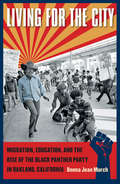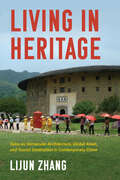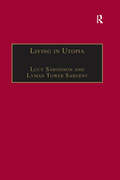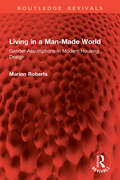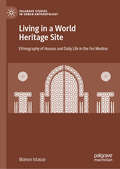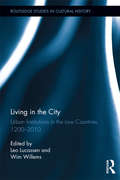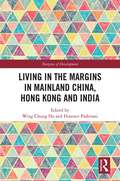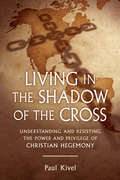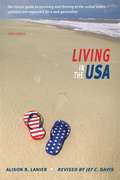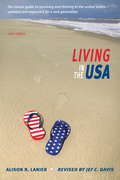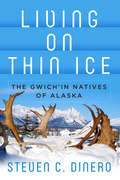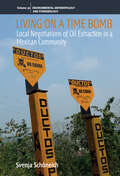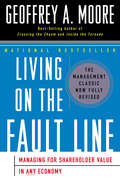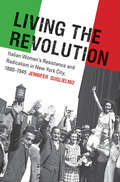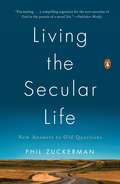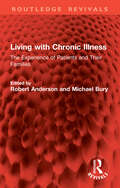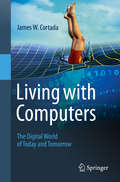- Table View
- List View
Living for the City: Migration, Education, and the Rise of the Black Panther Party in Oakland, California
by Donna Jean MurchIn this nuanced and groundbreaking history, Donna Murch argues that the Black Panther Party (BPP) started with a study group. Drawing on oral history and untapped archival sources, she explains how a relatively small city with a recent history of African American settlement produced such compelling and influential forms of Black Power politics. During an era of expansion and political struggle in California's system of public higher education, black southern migrants formed the BPP. In the early 1960s, attending Merritt College and other public universities radicalized Huey Newton, Bobby Seale, and many of the young people who joined the Panthers' rank and file. In the face of social crisis and police violence, the most disfranchised sectors of the East Bay's African American community--young, poor, and migrant--challenged the legitimacy of state authorities and of an older generation of black leadership. By excavating this hidden history,Living for the Citybroadens the scholarship of the Black Power movement by documenting the contributions of black students and youth who created new forms of organization, grassroots mobilization, and political literacy.
Living in Heritage: Tulou as Vernacular Architecture, Global Asset, and Tourist Destination in Contemporary China (Material Vernaculars)
by Lijun ZhangYongding County in southeast China is famous for its large, multistory communal vernacular buildings known as tulou, translated "rammed earth building." These structures were designated a UNESCO World Heritage Site in 2008. Living in Heritage introduces readers outside of China to this classic example of local Chinese architecture in the context of contemporary heritage preservation and tourism.Focusing on the Yongding Hakka Tulou Folk Culture Village, which is part of Hongkeng Village, author Lijun Zhang examines the on-the-ground processes and effects of heritage-making, UNESCO-inspired tourism, and how locals negotiate the dramatic transformation of their daily, social, and economic lives. Within an age of cultural change beginning at the start of the 21st century, Living in Heritage explores how the tulou phenomenon as heritage has and continues to be transformed into cultural, economic, or political capital. Through her careful study, Zhang reveals how the blurring of formerly distinct domains—private and public, local and global—gives rise to a living museum that now relies on insiders and outsiders to preserve their way of life.Living in Heritage offers an in-depth ethnographic account of the people dwelling and working within traditional tulou architecture in the 21st century.
Living in Utopia: New Zealand’s Intentional Communities
by Lyman Tower Sargent Lucy SargissonUtopia is, literally, the good place that is no place. Utopias reveal people's dreams and desires and they may gesture towards different and better ways of being. But they are rarely considered as physical, observable phenomena. In this book Sargisson and Sargent, both established writers on utopian theory, turn their attention to real-life utopian communities. The book is based on their fieldwork and extensive archival research in New Zealand, a country with a special place in the history of utopianism. A land of opportunity for settlers with dreams of a better life, New Zealand has, per capita, more intentional communities - groups of people who have chosen to live and sometimes work together for a common purpose - than any country in the world. Sargisson and Sargent draw on the experiences of more than fifty such communities, to offer the first academic survey of this form of living utopian experiment. In telling the story of the New Zealand experience, Living in Utopia provides both transferable lessons in community, cooperation and social change and a unique insight into the utopianism at the heart of politics, society, and everyday life.
Living in Worlds of Music
by Minette MansInformed by her in-depth ethnomusical knowledge, the result of detailed fieldwork, Mans's book is about musical worlds and how we as people inhabit them. The book asserts that an understanding of our musical worlds can be a transformative educational tool that could have a significant role to play in multicultural music and arts education. She explores the way in which musical expression, with its myriad cultural variations, reveals much about identity and cultural norms, and shows how particular musical sounds are aesthetically related to these norms. The author goes further to suggest that similar systems can be detected across cultures, while each world remains colored by a distinctive soundscape. Mans also looks at the way each cultural soundscape is a symbolic manifestation of a society's collective cognition, sorting musical behavior and sounds into clusters and patterns that fulfill each society's requirements. She probes the fact that in today's globalized and mobile world, as people move from one society to another, cross-cultural acts and hybrids result in a number of new aesthetics. Finally, in addition to three personal narratives by musicians from different continents, the author has invited scholars from diverse specializations and locations to comment on different sections of the book, opening up a critical dialogue with voices from different parts of the globe. Musical categorization, identity, values, aesthetic evaluation, creativity, curriculum, assessment and teacher education are some of the issues tackled in this manner.
Living in a Dangerous Climate
by Renée HetheringtonLiving in a Dangerous Climate provides a journey through human and Earth history, showing how a changing climate has affected human evolution and society. Is it possible for humanity to evolve quickly, or is slow, gradual, genetic evolution the only way we change? Why did all other Homo species go extinct while Homo sapiens became dominant? How did agriculture, domestication, and the use of fossil fuels affect humanity's growing dominance? Do today's dominant societies - devoted as they are to Darwinism and "survival of the fittest" - contribute to our current failure to meet the hazards of a dangerous climate? Unique and thought provoking, the book links scientific knowledge and perspectives of evolution, climate change, and economics in a way that is accessible and exciting for the general reader. The book is also valuable for courses on climate change, human evolution, and environmental science.
Living in a Man-Made World: Gender Assumptions in Modern Housing Design (Routledge Revivals)
by Marion RobertsThere are powerful assumptions about gender divisions inscribed in the built environment. Housing is the site of some complex processes in society. In making and remaking their homes, women and men define their place in the world and are defined by it. Taking a historical perspective, Living in a Man-Made World (originally published in 1991) is the first to make a complete examination of the relationship of gender to housing design. Design is seen in broad terms and revealed as part of the social process of society, rather than a separate sphere in which the architect has sole responsibility for decision making. Many of the ills of the contemporary environment can be traced to the barriers that have been built up between the concerns of social policy, planning and architecture. By breaking down these barriers through a synoptic study of how gender assumptions have operated in the design of housing, this book points the way to how improvements in design and in the built environment may be better achieved.
Living in a World Heritage Site: Ethnography of Houses and Daily Life in the Fez Medina (Palgrave Studies in Urban Anthropology)
by Manon IstasseThrough a thick ethnography of the Fez medina in Morocco, a World Heritage site since 1981, Manon Istasse interrogates how human beings come to define houses as heritage. Istasse interrogates how heritage appears (or not) when inhabitants undertake construction and restoration projects in their homes, furnish and decorate their spaces, talk about their affective and sensual relations with houses, face conflicts in and about their houses, and more. Shedding light on the continuum between houses-as-dwellings and houses-as-heritage, the author establishes heritage as a trajectory: heritage as a quality results from a ‘surplus of attention’ and relates to nostalgia or to a feeling of threat, loss, and disappearance; to values related to purity, materiality, and time; and to actions of preservation and transmission. Living in a World Heritage site provides a grammar of heritage that will allow scholars to question key notions of temporality and nostalgia, the idea of culture, the importance of experts, and moral principles in relation to heritage sites around the globe.
Living in the City: Urban Institutions in the Low Countries, 1200–2010 (Routledge Studies in Cultural History)
by Leo Lucassen Wim WillemsThe city is a place to find shelter, a market place, and an elevator for social mobility and success. But the city is also a place that frightens people and that can marginalize newcomers. Living in the City tries to understand what pulls people to the city since the High Middle Ages, focusing on one of the earliest urbanized regions in the world, the Low Countries. The book is a quest for new insights that leads the reader from Medieval Ghent and Bruges, through the Dutch Golden Age and the mass urbanization in the age of Industrialization to the present Eurodelta. A region that emerged in the last century with Antwerp, Rotterdam and Amsterdam as nodal points in a global urban network. To understand the motivations of so many to settle in cities this book focuses on a wide variety of urban institutions. What was the role of churches, guilds and businesses, but also theaters, architecture, parks and pavements? What were the cultural, economic, social, political and spatial dynamics that transformed cities into centers of creativity and innovation? How did the attractiveness of cities change over time, when cities lost their autonomy and became part of the nation state and global forces? In this book a team of internationally reknown scholars (in the field of history, art, literature, economy and the social sciences) look for continuity and change in the last eight centuries of urban developments in one of the most remarkable urban regions of the world.
Living in the Margins in Mainland China, Hong Kong and India (Margins of Development)
by Wing Chung Ho Florence PadovaniWith a range of case studies from Asia, this book sheds light on empirical realizations of marginality in a globalized context using first-hand original research.In the late 2000s, the financial crisis witnessed the fragility of high levels of market integration and the vulnerability of globalisation. Since then, the world seems to have entered an epoch of anxiety featuring populism with varying degrees of protectionism and nationalism. What is the nature of this populist mood as a backlash against globalisation? How do people feel about it and act upon it? Why should specific intellectual attention be paid to the increasingly marginalised by the recent macroscopic structural changes? These are the questions addressed by the contributors of this book, illustrated with specific cases from mainland China, Hong Kong and India, all of which have undergone substantial populist or nationalist movements since 2010.A valuable resource for sociologists looking to understand the impacts of globalization, especially those with a particular interest in Asia.
Living in the Shadow of the Cross: Understanding and Resisting the Power and Privilege of Christian Hegemony
by Paul KivelHow our dominant Christian worldview shapes everything from personal behavior to public policy (and what to do about it)Over the centuries, Christianity has accomplished much which is deserving of praise. Its institutions have fed the hungry, sheltered the homeless, and advocated for the poor. Christian faith has sustained people through crisis and inspired many to work for social justice.Yet although the word "Christian" connotes the epitome of goodness, the actual story is much more complex. Over the last two millennia, ruling elites have used Christian institutions and values to control those less privileged throughout the world. The doctrine of Christianity has been interpreted to justify the killing of millions, and its leaders have used their faith to sanction participation in colonialism, slavery, and genocide. In the Western world, Christian influence has inspired legislators to continue to limit women's reproductive rights and has kept lesbians and gays on the margins of society.As our triple crises of war, financial meltdown, and environmental destruction intensify, it is imperative that we dig beneath the surface of Christianity's benign reputation to examine its contribution to our social problems. Living in the Shadow of the Cross reveals the ongoing, everyday impact of Christian power and privilege on our beliefs, behaviors, and public policy, and emphasizes the potential for people to come together to resist domination and build and sustain communities of justice and peace.Paul Kivel is the award-winning author of Uprooting Racism and the director of the Christian Hegemony Project. He is a social justice activist and educator who has focused on the issues of violence prevention, oppression, and social justice for over forty-five years.
Living in the USA
by Jef C. Davis Alison R. LanierAs William Gay, distinguished adviser to the last edition, so aptly notes, the United States is ?a country that is never what you think it is. ' Since that edition was introduced nearly ten years ago, the country has been struggling with troubling, divisive events and issues, especially the September 11, 2001, attacks and the resulting War on Terror. Despite these extraordinary times, the United States still holds promise and opportunity for those who take the time to understand it. Jef Davis, a seasoned interculturalist and long-time adviser to international travelers, had succeeded as few could in creating an important new version of Living in the U. S. A. that will guide you through the confusing, conflicted, exciting country and its diverse population at an extraordinary time in history. New material and significantly revised chapters help you understand: American Cultures, such as sections on African Americans, Latinos, Asian Americans, Native peoples, retirees, gays and lesbians and the disables, underscoring the incredible diversity of culture and values that comprise the American population; Twenty-First Century Issues, for example the continued rise in religious fundamentalism in the U. S. and abroad and the tension between security and personal liberties; Getting Here and Getting Settled, including security at the airport and elsewhere and new and trying immigration regulations. Short-term visitors to the U. S. will find advice for surviving customs and immigration, finding as apartment, doing business, obtaining health care, and navigating the supermarket, bank, and post office. If you plan to stay longer, you will find practical pointers for getting along at work, school, and at home; buying a house; making and keeping American friends; and understanding dominant American values in a diverse and complex society. Living in the U. S. A. is a comprehensive guide to attitudes, customs, manners and daily life in the United States.
Living in the USA
by Alison R. Lanier Jef Davis Charles William GayAs William Gay, distinguished adviser to the last edition, so aptly notes, the United States is “a country that is never what you think it is.” Since that edition was introduced nearly ten years ago, the country has been struggling with troubling, divisive events and issues, especially the September 11, 2001, attacks and the resulting War on Terror. Despite these extraordinary times, the United States still holds promise and opportunity for those who take the time to understand it. Jef Davis, a seasoned interculturalist and long-time adviser to international travelers, had succeeded as few could in creating an important new version of Living in the U.S.A. that will guide you through the confusing, conflicted, exciting country and its diverse population at an extraordinary time in history. New material and significantly revised chapters help you understand: American Cultures, such as sections on African Americans, Latinos, Asian Americans, Native peoples, retirees, gays and lesbians and the disables, underscoring the incredible diversity of culture and values that comprise the American population; Twenty-First Century Issues, for example the continued rise in religious fundamentalism in the U.S. and abroad and the tension between security and personal liberties; Getting Here and Getting Settled, including security at the airport and elsewhere and new and trying immigration regulations. Short-term visitors to the U.S. will find advice for surviving customs and immigration, finding as apartment, doing business, obtaining health care, and navigating the supermarket, bank, and post office. If you plan to stay longer, you will find practical pointers for getting along at work, school, and at home; buying a house; making and keeping American friends; and understanding dominant American values in a diverse and complex society. Living in the U.S.A. is a comprehensive guide to attitudes, customs, manners and daily life in the United States.
Living on Thin Ice: The Gwich'in Natives of Alaska
by Steven C. DineroThe Gwich'in Natives of Arctic Village, Alaska, have experienced intense social and economic changes for more than a century. In the late 20th century, new transportation and communication technologies introduced radically new value systems; while some of these changes may be seen as socially beneficial, others suggest a weakening of what was once a strong and vibrant Native community. Using quantitative and qualitative data gathered since the turn of the millennium, this volume offers an interdisciplinary evaluation of the developments that have occurred in the community over the past several decades.
Living on a Time Bomb: Local Negotiations of Oil Extraction in a Mexican Community (Environmental Anthropology and Ethnobiology #30)
by Svenja SchöneichProviding a holistic understanding of extensive oil extraction in rural Mexico, this book focuses on a campesino community, where oil extraction is deeply inscribed into the daily lives of the community members. The book shows how oil shapes the space where it is extracted in every aspect and produces multiple uncertainties. The community members express these uncertainties using the metaphor of the time bomb. The book shows how they find ways to "live off the time bomb" by using mechanisms of short-term coping and long-term adaptation and thus, developing the capability to determine their lives despite the ever-changing challenges.
Living on the Fault Line
by Geoffrey A. MooreThe fault line -- that dangerous, unstable seam in the economy where powerful innovations and savage competition meet and create market-shattering tremors. Every company lives on it; no manager can control it. In the original edition of Living on the Fault Line, Geoffrey Moore presented a compelling argument for using shareholder value (or share price) as the key driver in management decisions. Moore now revisits his argument in the post-Internet bubble world, proving that the methods he espouses are more germane than ever and showing companies how to use them to survive and thrive in today's demanding economy. Extending the themes of Crossing the Chasm and Inside the Tornado, his first two books on the dynamics of the high-tech markets, Moore shows why sensitivity to stock price is the single most important lever for managing in the future, both as a leading indicator of shifts in competitive advantage and as an employee motivator for making necessary changes in organizations heretofore impervious to change. This revised and updated edition includes: A deeper emphasis on core versus context, which has emerged as the key distinction in allocating resources to improve shareholder value A new Competitive Advantage Grid that will aid managers in achieving and sustaining competitive advantage, the most important component in managing for shareholder value An expanded Value Discipline Model as it relates to the Competitive Advantage Grid Analysis of the powerful new trend toward core/context analysis and outsourcing production duties Updated models of organizational change for each stage of market developmentAs disruptive forces continue to buffet the marketplace and rattle the staid practices of the past, Moore offers a brilliant set of navigational tools to help meet today's most compelling management challenges.
Living on the Fault Line,ition
by Geoffrey A. MooreThe fault line -- that dangerous, unstable seam in the economy where powerful innovations and savage competition meet and create market-shattering tremors. Every company lives on it; no manager can control it. In the original edition of Living on the Fault Line, Geoffrey Moore presented a compelling argument for using shareholder value (or share price) as the key driver in management decisions. Moore now revisits his argument in the post-Internet bubble world, proving that the methods he espouses are more germane than ever and showing companies how to use them to survive and thrive in today's demanding economy. Extending the themes of Crossing the Chasm and Inside the Tornado, his first two books on the dynamics of the high-tech markets, Moore shows why sensitivity to stock price is the single most important lever for managing in the future, both as a leading indicator of shifts in competitive advantage and as an employee motivator for making necessary changes in organizations heretofore impervious to change. This revised and updated edition includes: A deeper emphasis on core versus context, which has emerged as the key distinction in allocating resources to improve shareholder value A new Competitive Advantage Grid that will aid managers in achieving and sustaining competitive advantage, the most important component in managing for shareholder value An expanded Value Discipline Model as it relates to the Competitive Advantage Grid Analysis of the powerful new trend toward core/context analysis and outsourcing production duties Updated models of organizational change for each stage of market developmentAs disruptive forces continue to buffet the marketplace and rattle the staid practices of the past, Moore offers a brilliant set of navigational tools to help meet today's most compelling management challenges.
Living the Dream: A Documentary Study of Twin Oaks Community
by Ingrid KomarDescribes Twin Oaks, an egalitarian community in central Virginia, focusing on the period between 1979 and 1982.
Living the Global City: Globalization as Local Process
by John EadePoliticians and academics alike have made globalization the key reference point for interpreting the 1990s. For many, globalization threatens both community and the nation-state. It appears to represent forces beyond human control. Living the Global City documents globalization's impact on everyday lives by drawing on research rather than rhetoric and arrives at a very different perspective. Living the Global City offers an analysis of globalization and global/local processes by focussing on specific issues and themes which include community, culture, milieu, socioscapes and sociospheres, microglobalization, poverty, ethnic identity and carnival. By advancing the debates which surround these issues through a redefinition of the terms in which they have been developed and engagement with the everyday lives of people in a global city, this book reveals how such key concepts as community, culture, class, poverty and identity can be reconceptualized in the context of global/local processes.
Living the Revolution: Italian Women's Resistance and Radicalism in New York City, 1880-1945
by Jennifer GuglielmoItalians were the largest group of immigrants to the United States at the turn of the twentieth century, and hundreds of thousands led and participated in some of the period's most volatile labor strikes. Yet until now, Italian women's political activism and cultures of resistance have been largely invisible. In Living the Revolution, Jennifer Guglielmo brings to life the Italian working-class women who helped shape the vibrant, transnational, radical political culture that expanded into the emerging industrial union movement. Guglielmo imaginatively documents the activism of two generations of New York and New Jersey women who worked in the needle and textile trades. She explores the complex and distinctive ways immigrant women and their American-born daughters drew on Italian traditions of protest to form new urban female networks of everyday resistance and political activism. And she shows how their commitment to revolutionary and transnational social movements diminished as they became white working-class Americans. The rise of fascism, the Red Scare, and the deprivations of the Great Depression led many to embrace nationalism and racism, ironically to try to meet the same desires for economic justice and dignity that had inspired their enthusiasm for anarchism, socialism, and communism.
Living the Secular Life
by Phil ZuckermanA Best Book of 2014, Publishers Weekly "Zuckerman is a sociologist who in this groundbreaking book writes clearly, offers unobtrusive statistical support, and provides a persuasive and comprehensive look at the growing contemporary phenomenon of people who choose to live without religion, but with ethics and meaning in their lives." Over the last twenty-five years, "no religion" has become the fastest-growing religion in the United States. Around the world, hundreds of millions of people have turned away from the traditional faiths of the past and embraced a moral yet nonreligious--or secular--life, generating societies vastly less religious than at any other time in human history. Revealing the inspiring beliefs that empower secular culture--alongside real stories of nonreligious men and women based on extensive in-depth interviews from across the country--Living the Secular Life will be indispensable for millions of secular Americans. Drawing on innovative sociological research, Living the Secular Life illuminates this demographic shift with the moral convictions that govern secular individuals, offering crucial information for the religious and nonreligious alike. Living the Secular Life reveals that, despite opinions to the contrary, nonreligious Americans possess a unique moral code that allows them to effectively navigate the complexities of modern life. Spiritual self-reliance, clear-eyed pragmatism, and an abiding faith in the Golden Rule to adjudicate moral decisions: these common principlesare shared across secular society. Living the Secular Life demonstrates these principles in action and points to their usage throughout daily life. Phil Zuckerman is a sociology professor at Pitzer College, where he studied the lives of the nonreligious for years before founding a Department of Secular Studies, the first academic program in the nation dedicated to exclusively studying secular culture and the sociological consequences of America's fastest-growing "faith." Zuckerman discovered that despite the entrenched negative beliefs about nonreligious people, American secular culture is grounded in deep morality and proactive citizenship--indeed, some of the very best that the country has to offer. Living the Secular Life journeys through some of the most essential components of human existence--child rearing and morality, death and ritual, community and beauty--and offers secular readers inspiration for leading their own lives. Zuckerman shares eye-opening research that reveals the enduring moral strength of children raised without religion, as well as the hardships experienced by secular mothers in the rural South where church attendance defines the public space. Despite the real sorrows of mortality, Zuckerman conveys the deep psychological health of secular individuals in their attitudes toward illness, death, and dying. Tracking the efforts of nonreligious groups to construct their own communities, Zuckerman shows how Americans are building institutions and cultivating relationships without religious influence. Most of all, Living the Secular Life infuses the sociological data and groundbreaking research with the moral convictions that govern secular individuals, and demonstrates how readers can integrate these beliefs into their own lives. A manifesto for a booming social movement--and a revelatory survey of this overlooked community--Living the Secular Life offers essential and long-awaited information for anyone building a life based on his or her own principles. an interest in Dawkins, Harris, Hitchens, et al., you certainly need to pick this book up and find out where things are headed." Bart Campolo, author Things We Wish We Had Said "Since coming out as a post-Christian minister, I've discovered all kinds of people sincerely pursuing goodness without the nurture, encouragement, and mutual support most church folks take for granted. These folks are hungry for fellowship and pastoral care, but even hungrier for a thoughtful, positive way to communicate their values and commitments to friends and family...
Living the Secular Life
by Phil Zuckerman"A humane and sensible guide to and for the many kinds of Americans leading secular lives in what remains one of the most religious nations in the developed world." --The New York Times Book Review Over the last twenty-five years, "no religion" has become the fastest-growing religious preference in the United States. Around the world, hundreds of millions of people have turned away from the traditional faiths of the past and embraced a moral yet nonreligious--or secular--life, generating societies vastly less religious than at any other time in human history. Revealing the inspiring beliefs that empower secular culture--alongside real stories of nonreligious men and women based on extensive in-depth interviews from across the country--Living the Secular Life will be indispensable for millions of secular Americans.Drawing on innovative sociological research, Living the Secular Life illuminates this demographic shift with the moral convictions that govern secular individuals, offering crucial information for the religious and nonreligious alike. Living the Secular Life reveals that, despite opinions to the contrary, nonreligious Americans possess a unique moral code that allows them to effectively navigate the complexities of modern life. Spiritual self-reliance, clear-eyed pragmatism, and an abiding faith in the Golden Rule to adjudicate moral decisions: these common principles are shared across secular society. Living the Secular Life demonstrates these principles in action and points to their usage throughout daily life.Phil Zuckerman is a sociology professor at Pitzer College, where he studied the lives of the nonreligious for years before founding a Department of Secular Studies, the first academic program in the nation dedicated to exclusively studying secular culture and the sociological consequences of America's fastest-growing "faith." Zuckerman discovered that despite the entrenched negative beliefs about nonreligious people, American secular culture is grounded in deep morality and proactive citizenship--indeed, some of the very best that the country has to offer.Living the Secular Life journeys through some of the most essential components of human existence--child rearing and morality, death and ritual, community and beauty--and offers secular readers inspiration for leading their own lives. Zuckerman shares eye-opening research that reveals the enduring moral strength of children raised without religion, as well as the hardships experienced by secular mothers in the rural South, where church attendance defines the public space. Despite the real sorrows of mortality, Zuckerman conveys the deep psychological health of secular individuals in their attitudes toward illness, death, and dying. Tracking the efforts of nonreligious groups to construct their own communities, Zuckerman shows how Americans are building institutions and cultivating relationships without religious influence. Most of all, Living the Secular Life infuses the sociological data and groundbreaking research with the moral convictions that govern secular individuals and demonstrates how readers can integrate these beliefs into their own lives.A manifesto for a booming social movement--and a revelatory survey of this overlooked community--Living the Secular Life offers essential and long-awaited information for anyone building a life based on his or her own principles. an interest in Dawkins, Harris, Hitchens, et al., you certainly need to pick this book up and find out where things are headed." Bart Campolo, author Things We Wish We Had Said "Since coming out as a post-Christian minister, I've discovered all kinds of people sincerely pursuing goodness without the nurture, encouragement, and mutual support most church folks take for granted. These folks are hungry for fellowship and pastoral care, but even hungrier for a thoughtful, positive way to communicate their values and commitments to friends and family members instinctively distrustful of anyone who doesn't believe in God. For them--and for me--Phil Zuckerman is a genuine hero, and Li...
Living with Alzheimer's: Managing Memory Loss, Identity, and Illness
by Renée L. BeardNews of Alzheimer’s disease is constantly in the headlines. Every day we hear heart-wrenching stories of people caring for a loved one who has become a shell of their former self, of projections about rising incidence rates, and of cures that are just around the corner. However, we don't see or hear from the people who actually have the disease. In Living with Alzheimer’s, Renée L. Beard argues that the exclusively negative portrayals of Alzheimer’s are grossly inaccurate. To understand what life with memory loss is really like, Beard draws on intensive observations of nearly 100 seniors undergoing cognitive evaluation, as well as post-diagnosis interviews with individuals experiencing late-in-life forgetfulness. Since we all forget sometimes, seniors with an Alzheimer’s diagnosis ultimately need to be socialized into medicalized interpretations of their forgetfulness. In daily life, people with the disease are forced to manage stigma and the presumption of incompetence on top of the actual symptoms of their ailment. The well-meaning public, and not their dementia, becomes the major barrier to a happy life for those affected. Beard also examines how these perceptions affect treatment for Alzheimer’s. Interviews with clinicians and staff from the Alzheimer’s Association reveal that despite the best of intentions, pejorative framings of life with dementia fuel both clinical practice and advocacy efforts. These professionals perpetuate narratives about “self-loss,” “impending cures,” and the economic and emotional “burden” to families and society even if they do not personally believe them. Yet, Beard also concludes that in spite of these trends, most of the diagnosed individuals in her study achieve a graceful balance between accepting the medical label and resisting the social stigma that accompanies it. In stark contrast to the messages we receive, this book provides an unprecedented view into the ways that people with early Alzheimer’s actively and deliberately navigate their lives.
Living with Chronic Illness: The Experience of Patients and Their Families (Routledge Revivals)
by Michael Bury Robert AndersonFirst published in 1988, Living with Chronic Illness presents a vivid account of the reality of life with chronic illness – from the perspective of patients and their families. The authors look at the expectations, priorities, and problems of those most affected by chronic illness, and examine the strategies they have developed to cope with their considerable disadvantages. The experience of carers, the ways in which their problems change over time, are also major themes in the book.The book looks at the everyday life of people with the following conditions: stroke, renal failure, multiple sclerosis, Parkinson’s disease, arthritis, heart attack, epilepsy, rectal cancer, psoriasis, and diabetes. In each case, an overview of the consequences of a particular illness is presented, before discussion of specific problems in daily life – maintaining family relationships, managing treatment regimes, coping with work and home commitments, and living with bodily change and social stigma.This volume will be of importance to all those concerned with providing support and planning care for the chronically ill – in the health and social services and in voluntary organizations. Students of medical sociology, policy makers and planners will also find the insights and research presented here valuable in the understanding of the daily life of people with chronic illness. It will also be of use for those in professional training, in nursing, social work, general practice and related areas.
Living with Class
by Brian Seitz Ron ScappA philosophical-cultural exploration, this book expands the discussion of "class" from a novel perspective. Following the current debates about wealth and class, the contributors address the social and cultural phenomena of class from a uniquely innovative philosophical approach and reconsider philosophical "givens" within the context of culture.
Living with Computers: The Digital World of Today and Tomorrow
by James W. CortadaThe computing technology on which we are now so dependent has risen to its position of ascendency so rapidly that few of us have had the opportunity to take a step back and wonder where we are headed. This book urges us to do so.Taking a big-picture perspective on digital technology, Living with Computers leads the reader on a whistle-stop tour of the history of information and information technology. This journey culminates in a deep exploration into the meaning and role of computers in our lives, and what this experience might possibly mean for the future of human society – and the very existence of humanity itself.In the face of the transformative power of computing, this book provokes us to ask big questions. If computers become integrated into our bodies, merging with the information processing of our very DNA, will computing help to shape the evolution of biological life? If artificial intelligence advances beyond the abilities of the human brain, will this overturn our anthropocentrism and lead to a new view of reality? Will we control the computers of the future, or will they control us?These questions can be discomforting, yet they cannot be ignored. This book argues that it is time to reshape our definition of our species in the context of our interaction with computing. For although such science-fiction scenarios are not likely to happen any time soon – and may, in fact, never happen – it is nevertheless vital to consider these issues now if we wish to have any influence over whatever is to come. So, humans, let’s confront our possible destiny!James W. Cortada is a Senior Research Fellow at the Charles Babbage Institute at the University of Minnesota. He holds a Ph.D. in modern history and worked at IBM in various positions for 38 years, including in IBM’s management research institute, The IBM Institute for Business Value (IBV). He is the author of over a dozen books on management, and nearly two dozen books on the history of information technology. These include the Springer title From Urban Legends to Political Fact-Checking: Online Scrutiny in America, 1990-2015 (with William Aspray).
